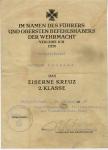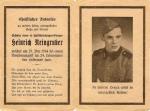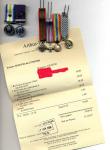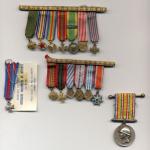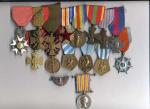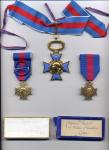-
Posts
2,284 -
Joined
-
Last visited
-
Days Won
6
Content Type
Profiles
Forums
Blogs
Gallery
Events
Store
Everything posted by PKeating
-
An EK2 document to a Senior NCO serving with 1. Fallschirm-Korps in Italy with rare hand signature of corps commander Alfred Schlemm and bearing his headquarters stamp. 1. FK were defending the Gothic Line in northern Italy at this time. Schlemm held the RK, DKiG, Knight?s Cross of the Hohenzollern House Order and a host of other awards. Schlemm signed this document just before handing over to Generalleutnant Richard Heidrich in Northern Italy and moving to Holland, where he ended up as commander of 1. Fallschirm-Armee before being wounded and captured in March 1945. He died in 1986. Schlemm was widely suspected of condoning if not sanctioning the war crimes committed in Tuscany by 4. Fallschirmj?ger-Division and the Hermann G?ring Division in the summer of 1944. Schlemm signatures are rarely encountered. PK
-
Here are a couple to set the ball rolling. Robert Kohnen's document bears a manuscript Student signature. His EKI was certainly for Crete as the 2. Kompanie did not participate in the jump over the Corinth Canal. 2./Fallschirm-Sanit?ts-Abt 7 jumped to the west of Heraklion, near Gazi, with III./Fallschirmj?ger-Rgt 1 on May 20th 1941 as part of Gruppe Ost. The company commander was Stabsarzt Dr. Carl Langemeyer, who would later win the DKiG and the RK. The clerical error is interesting in that the unit had been redesignated Fallschirm.Sanit?ts.Abteilung. XI.Flieger-Korps in October 1940. Obergefreiter and Kriegsberichter Finkler jumped with 2./Fallschirm-Sanit?ts-Abt 7 and took many photos of the 2. Kompanie during the battle. Some of these can be seen in Jean-Yves Nasse's excellent book Fallschirmj?ger en Cr?te. The Fallschirm-Sanit?ts-Abt returned to their base in Brandenburg after Crete and remained there until their departure for Russia at the end of the year. Decorations were awarded while the Fallschirmj?ger were still on the island of Crete after the battle but many awards were also made back at their bases in Germany in June and July.
-
Leutnant K?hne was attached to 15./FJR1 as a platoon commander for the Moerdijk jump, winning his EK2 for leading a successful assault on a heavily defended bunker, an action in which he was wounded. At the Corinth Canal in April 1941, K?hne and his men captured a British anti-aircraft battery, taking many prisoners. Recommended for the RK, he received the EK1 instead. He survived Crete and Russia, being transferred to Tunisia in 1942, where he took part in the Ramcke-Brigade?s extraordinary two-hundred mile trek from El Alamein back to German lines in November 1942. There followed Sicily, Anzio-Nettuno, Monte Cassino and the rest of the fighting withdrawal up the Italian peninsula but his finest moment was as CO of I./Fallschirmj?ger-Rgt 2 and the capture of the Greek island of Leros in Operation Taifun, which brought him the Ritterkreuz. Born in 1918, Herr K?hne died a few years ago. He apparently made a present of this document to Klaus Peters. It was then acquired by George Petersen, from whom I acquired it. K?hne held the RK, DKiG, Ehrenpokal, EK1, EK2 and FSA, amongst other awards. He saw action at Moerdijk, Corinth, in Crete, Russia, Tunisia, Sicily, Italy, Leros and, again, Italy. He finished up as a Major with FJR10 in 1945. PK
-

Waffen SS Death Notice
PKeating replied to PKeating's topic in Germany: Third Reich: Research, Documentation & Photographs
Well done. He was a member of SS-Fallschirmj?ger-Btl 500, tasked with a parachute and gliderborne assault on Tito's HQ in Drvar on 25.5.1944. PK -

EK 1914 Document - EK1 to Jew
PKeating replied to Igor Ostapenko's topic in Germany: All Eras: The Iron Cross
As a matter of interest, Franz Hermann Karl Otto von Etzel was the brother of G?nther von Etzel, who held the Pour-le-M?rite Order with Oakleaves. Here is the family website: http://www.vonetzel.com/ G?nther and Franz von Etzel were both generals. PK -

EK 1914 Document - EK1 to Jew
PKeating replied to Igor Ostapenko's topic in Germany: All Eras: The Iron Cross
The author of the thread is from Israel. If you can nurture an interest in British medals awarded to Indians or South Asians, surely a Jewish student and collector can be interested in an Iron Cross to a German-Jewish hero? In fact, for the sake of pedantry, Rothman was a German, fighting for his fatherland when he won the EK1, whereas the Indians who received British medals were collaborating with the enemy. An Iron Cross to an African would be interesting too. I think it is very relevant, given Herr Rothman's subsequent emigration to Palestine/Israel. This is an extremely poignant WW1 Iron Cross group. Rothman was relatively fortunate, although he looks quite haunted in the later photograph. A victim of Kristallnacht, perhaps? There were Iron Cross holders like Rothman who faced the Einsatzgruppen wearing their decorations, making the executioners uncomfortable. And the officer who recommended Hitler for the EK1 was a Jew. So, yes, it's relevant. PK -

EK 1914 A very special Langemarck EK1
PKeating replied to webr55's topic in Germany: All Eras: The Iron Cross
What a wonderful piece! Thank you for sharing it with us. PK -
You don't need DM's book to recognise these as awful fakes. The crosses correspond to nothing produced by any of the licenced manufacturers before May 1945 and the EL and ELS are crude copies of Godet items. PK
-
Thank you, Bison. So that is what the lower two grades of my neck order look like. Je suppose que je pourrais aller chez Arthus Bertrand ou m?me Marie Stuart pour en acheter mais j'aimerais mieux attendre jusque je rencontre un exemplaire faisant partie d'un groupement. It is better-looking than the Croix des Service Militaires Volontaires although the overall designs are very similar. PK
-
My thanks, also, for explaining exactly what these decorations were for. PK
-

EK 1939 Denazified Iron Crosses
PKeating replied to ksg's topic in Germany: All Eras: The Iron Cross
Hallo Eric! IMO, that cross left the makers as a vaulted piece. It's as clear as the noses on the ends of our faces. Nice! P -

EK 1939 Denazified Iron Crosses
PKeating replied to ksg's topic in Germany: All Eras: The Iron Cross
What a wonderful thing! I haven't studied the beading details to see who might have made this but unless it has been manually bent for the vaulted look, there were relatively few firms offering vaulted 1939 EK1, pinback or screwback. It seems that the swastika has been removed and the core repainted. Is that the case? Or it this a cross actually made as-is? PK -
I would imagine that the really small ones are intended for medal chains, as worn on suit or blazer lapels, whilst the larger ones are for suspension hangers like the ones above, and would be worn on civilian jackets and coats, military mess dress and that sort of thing. Whatever the case, French miniatures are smaller than British miniatures, which poses a problem for veterans decorated by both countries, as this picture shows. I bought these miniatures for a British WW2 veteran of N? 4 Commando because he was attending a function at the French embassy in London. I put a couple of British miniatures - belonging to a friend - beside them to show the old commando the size before I sent them over. I am told that one or two British firms made some French miniatures during and after WW2 to British dimensions but we couldn't find any. PK
-
His miniatures. The fifth one from the left is the unofficial Volunteers' Medal with the "Engag? Volontaire" clasp. He wouldn't have been allowed to wear it on his uniform but he couldn't be prevented from including bling amongst his miniatures in civilian dress. I am sure our colleague "V?t?ran" will not object if I take the liberty of posting his remarks on this medal in another forum: Mais non, mon cher Paul, comment est-ce qu'il y aurait la moindre confusion? It's not at all muddled. No sir! It's just we are all a bit muddled... PK
-
I think the order of precedence for military awards is as follows. Military awards precede civil awards, the LdH aside. On combat fatigues, it often looks as if the wearer just pins them on any which way, with the really important ones like the LdH, MM, CdG and CdlVM foremost. But on the medal bars, ribbon bars and miniature racks I have observed here in France, this is how it seems to work. I am just focusing on WW1 and WW2 groups. Bravery and merit awards: L?gion d'Honneur; M?daille Militaire; Croix de Guerre; Croix de la Valeur Militaire; M?daille des Bless?s; Croix du Combattant Volontaire (incl R?sistance) I have seen veterans with civilian orders like the Ordre Nationale du M?rite (1963) just after their M?daille Militaire and LdH, if held but in the main, the civilian stuff, like the various merit and academic orders, is tacked onto the end. Commemorative medals: M?daille de la Victoire (Inst 20.7.1922); M?daille Comm?morative de la Grande Guerre (inst 23.6.1920); M?daille Comm?morative de la Guerre 1939-1945 (inst 21.5.1946); M?daille de la Campagne d'Italie (inst 1.4.1953);M?daille des Services Volontaires de la France Libre (inst 4.4.1946); M?daille de la Campagne d'Indochine (inst 1.8.1953); M?daille Fran?aise des Op?rations de l'Organisation des Nations Unies en Cor?e (inst 8.1.1952); M?daille des Op?rations de S?curit? et de Mantien de l'Orde en Afrique du Nord (inst 11.1.1958)*; M?daille des Op?rations au Moyen Orient (inst 22.5.1957)**; M?daille Comm?morative Fran?aise (inst 9.10.1995)*** *Basically, Algeria but also for service in Tunisia and Morocco **This is effectively the French "Suez Medal" ***For military operations abroad after 1.3.1991, which means the Balkans, Chad, West Africa, Afghanistan and so on. Honour awards: M?daille de la Reconnaissance Fran?aise (inst 13.7.1917); M?daille des ?vad?s (inst 20.8.1926); M?daille des Prisonniers Civils, D?port?s et Otages de la Guerre 1914-1918 (inst 14.3.1936); M?daille de la R?sistance (inst 19.2.1943); M?daille de la D?portation et de l'Internement pour Faits de R?sistance (inst 6.8.1948)*; M?daille de la D?portation et de l'Internement Politique (inst 9.9.1948)**; Insigne du R?fractaire (inst 21.10.1963)***; M?daille de la France Liber?e (inst 12.9.1947; Insigne des Bless?s de Guerre (inst 27.7.1916); M?daille de la D?fence Nationale (inst 21.4.1982); M?daille des Services Militaires Volontaires (inst 13.3.1975); M?daille de la Service de Sant? des Arm?es (inst 30.8.1962); M?daille d'Outre-Mer (inst 6.6.1962)****; M?daille de l'Afrique du Nord (inst 29.4.1997) *Ribbon with vertical stripes indicates an award to Deportees (generally to KZ-Lagers) and diagonal stripes denotes Internees. You see both being worn if the recipient was interned and deported. The medals are identical in both cases. **Same ribbon rules apply as per the Resistance version but this medal is for non-Resistance people interned and/or deported by Vichy or the Germans. ***A medal given to STO workers, many of whom ended up in the FFI. FTP and the FFL around the time of Liberation. My cousin wears one in his rack. ****Replacement for the old M?daille Coloniale. Pre-1962 veterans would thus wear the Colonial Medal in this order. So, that provides a basic guide to the order in which medals should be worn by French military personnel from 1914 to the present day. Oh, yes, the Croix de Guerre de TO obviously ranks equal to the WW1 and WW2 crosses. I have seen both being worn, of course, with the World War versions taking precedence. But I think that about covers it. Make of it what you will! Paddy Keating Here's a impressive group to a veteran of both wars who was also a long-serving fireman. Again, his papers had been binned by the house-clearers who took these, and the miniatures, to a coin dealer mate of mine in the belief that they would get rich. If the FFI fighter's badge is his, then I can probably find out who he was as these are numbered. Mind you, there should also be other ways. Look at this rack!
-
Here we have the Bronze and Gold grades of the Croix des Service Militaires Volontaires, extant from 1934 to 1957. These are interesting because they came with a group whose papers were lost, as is so often the case, but the little cardboard boxes have the recipient's name and rank noted on them, so there is a lead to follow. Pictured with them is the rarely-seen Commander grade of the Ordre du M?rite Militaire, extant from 1957 to 1963. Made of silver-gilt with blue enamel, this neck piece is by the Paris maker Arthus-Bertrand. The lower two grades were made in silver. Note how the design of the old Croix des Services Militaires Volontaires has been taken over. PK
-
You're the second person to cal me "Paul" in two days here! LOL! It's Paddy, BTW. You're absolutely right about the Stars on the ribbons of the medals themselves. The veteran was obviously unable to obtain full size Stars at the time. A couple have also migrated between the Valour Cross and its ribbon bar and his 1939-1945 War Medal should be wearing the Extreme Orient clasp seen on the Colonial Service Medal. The Indochine clasp belongs on the Colonial medal. This group came to me from one of the fellows who keeps an eye out for such things around Paris. These fellows are briefed to ask about the papers and, more often than not, the grandchildren flogging the medals have thrown the papers in the bin. Sometimes one gets lucky but I would have loved to have had the man's name as he was a serious Indo-China hand, serving there during the Japanese occupation and winning three Croix de Guerre. As Bison says, this was also awarded in the early stages of the Indo-China War. The small Colonial Service Medal is popularly known as the "Free French type". This man also served in the 1945-1954 Indo-China War, as his campaign medal indicates, and he may have served afterwards in Algeria, winning four Croix de la Valeur Militaire, this decoration being instituted in 1956. This would have entitled him to a further campaign medal, which he may not have claimed. Ahhhhh, if only the little so-and-so who probably took these away for sale when granddad died had taken his papers too... PK
-
-
Just about perfect, apart from missing the lower pair of prongs, which are incredibly fragile on these early types. PK
-
It's one of "those pieces", isn't it? As you pointed out, the repairs add a real poignance, don't they? Oh Lord...imagine a group of men and women in some humid forest clearing in the spring of '44, parading in a soldierly fashion, with this fanion tied to the bayonet of whatever rifle they had that took a bayonet, going through the motions of being a military unit, some of them having been soldiers, others learning their craft in the maquis, all of them with knotted guts as they thought of the tasks before them, going up against heavily armed veterans of Russia, Africa and Italy. It's the only FTP piece I have. They're that rare. You've seen my modest FFI collection. FFI stuff is also rare. These FTP and FFI fanions, armbands, badges and other things only appeared in the months leading up to and the weeks after the Normandy and Provence landings. They were an attempt to legitimise resistance fighters. The Free French even included insignia in their UK and and US-sponsored parachute drops of arms and supplies in 1943 and 1944, as I showed you, Chris, but the Wehrmacht was disinclined to recognise these fighters as legitimate. If anyone's interested, I'll post some examples of the limited material I have been lucky enough to find... PK
-
Original FTPF material is hard to find. I was lucky enough to acquire this company fanion used by the 8th Company of the 3rd Battalion of the FTPF, which adopted the honorific title "Bernard Palissy", a famous French potter and porcelain maker of the 16th century, who worked in the town of Agen, in the operational zone of the 3?me FTPF. FTPF stands for Francs tireurs parisans fran?ais. They were sometimes known as the FTPC or Francs tireurs partisans communistes. This fanion uses FTPF but the red star indicates the resistance movement's predominantly communist leanings. The FTP - as the movement is also known - were the counterparts to the FFI or Forces fran?aises de l'int?rieur, which enjoyed General de Gaulle's approval. Many FTP fighters had military experience, either with the French armed forces in the colonies and the War of 1939-1940 or in the Spanish Civil War. More than a few were hardened street fighters who had belonged to far left gangs in the 1930s. The movement took its name from the earlier Francs tireurs of the 19th century, which were, in a sense, the closest thing France had to territorial and militia units. The FTP of the Second World War could be considered as the armed wing of the Front National, the 1930s communist political movement founded by French Communist Party members, and nothing to do with the postwar Front National which we associate with Jean-Marie Le Pen. Prior to the invasion of the USSR by Germany in June 1941, no resistance was offered against the German presence in France by the French Communist Party and its various branches, although some communists broke ranks on an individual basis, and were either expelled from the movement or assassinated in line with typical communist methods. Following the invasion, the FTP became the first resistance group in France to inflict casualties on the Wehrmacht. The movement was "integrated" into the Gaullist FFI in February 1944, although many units refused to recognise the order from London, seeing de Gaulle as a representative of the Conservative establishment they detested. They were efficient fighters in the main. One of their most spectacular battles took place in August 1944 in the northern Parisian suburb of St-Denis, when the local FTP ambushed a retreating German column, leaving the centre of St-Denis looking rather like Stalingrad. The 3rd FTPF, operating in the region around the town of Agen, roughly halfway between Bordeaux and Montauban, mounted a number of attacks and ambushes on units of the Das Reich Division as it formed up and began moving towards Normandy along the N20 highway in June 1944. With many trade unionists, factory hands, railwaymen and other French infrastructure workers in its ranks, the FTP was also able to implement sabotage at all levels without even having to use arms. It is fair to say that there was a general tendency in France after the war to airbrush the FTP out of the picture, although this was resisted by veterans and by fair-minded historians. Nevertheless, many French people whose knowledge of the Second World War is quite extensive are quite surprised to learn, for instance, of the "Battle of St-Denis" and other episodes involving the FTP. Official histories record many of their actions as FFI enterprises in view of the order of February 1944. It boiled down, really, to the French establishment's prewar fear of Bolshevism, which was then overtaken by the exigencies of the Cold War. Yet wartime and postwar generations of French working class people remembered the part played in resistance by the FTP, which they saw very much as the armed wing of the French Communist Party - not unlike the relationship between S?nn Fein and the IRA - and the FCP has since enjoyed significant political power in France, although that power seems to be waning today. PK
-
Well, it would be, indeed, but I would have thought that a senior NCO's board would have had metallic furniture. That said, we've all seen NCOs' boards from various branches of the various services with embroidered monograms. I think I once saw a photo of an officer with GFP cyphers. Does anyone know of any photos and could they post them here? They were certainly worn but I suspect that they were rather like, say, SAS Parachute Wings in the British Army: worn from time to time but rarely seen out and about, so to speak. PK


